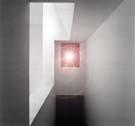Josiah McElheny
dal 31/3/2002 al 1/6/2002
Segnalato da
31/3/2002
Josiah McElheny
Centro Galego de Arte Contemporanea CGAC, Santiago de Compostela
The work of Josiah McElheny exists in the space between the factual, the historic, the imagined, the fantastic. Often accompanied by a description which places the work in another dimension, that of narration or historical perspective, the actual pieces suggest another, possible, world?..a world of the present, a world of the imagination.

April - June
Curator: Michael Tarantino
"Much of the ancient glass found today is recovered from tombs that
protected it from the nearly inevitable breakage aboveground. The
ancients buried domestic objects with their dead for use in the
afterlife, and as a reminder of their former life.
"We know that Julius Alexander was married, as his wife left the hairpin
he made for her in his tomb. We know that he practiced his art in Gaul
but was a citizen of Rome, possibly born in Africa, Egypt or Carthage.
"We believe he blew the pieces found in the tomb but since they are
without signature we can only be sure that he made the hairpin. Earlier
historians attribute certain bottles found in Rome to his workshop. The
'stele' is in the Musee des Beaux Arts in Lyon. In his tomb was common
domestic glass of the third century, six bottles, four plates, two cups,
one hairpin."
Josiah McElheny, text from "The Only Known Grave of a Glassblower" (1994)
The work of Josiah McElheny exists in the space between the factual, the
historic, the imagined, the fantastic. Often accompanied by a
description which places the work in another dimension, that of narration
or historical perspective, the actual pieces suggest another, possible,
world?..a world of the present, a world of the imagination.
McElheny's show at the Centro Gallego de Arte Contemporanea will be the
first major exhibition of his work organized by a European museum. It
will feature three important works: "Untitled (White)"
( ), "Verzelini's Acts of Faith" ( ) and "A Historical Anecdote
About Fashion" (1999), as well as a new piece commissioned by CGAC.
Together they illustrate the various aspects of McElheny's practice,
which can seem both seductive and puzzling: the objects which are
evidence of the artist's skill in glass-blowing, learned through years of
apprenticeship; the tension between reconstructing history and imagining
history; the relationship between the fabricated and the appropriated
object; the tension between architecture and the objects and spaces
contained within; the notion of display and how it effects our viewing of
an object; the relationship between text and object; etc. Together, all
of these elements provide a rich experience for the viewer: he/she must
take an active position in entering McElheny's world. They must filter
and edit the information provided for them in order to provide a coherent
whole. Which is not to say that the image they form is going to be
definitive.
McElheny consistently explores the interstices between fact in fiction.
In "An Historical Anecdote About Fashion" (1999), we read the following
text:
"In the 1952 Venice Biennial, Venini, the famous glass design company,
entered a display of vases designed not by the factory's artists and
architects, but by the glassblowers. The unusual shapes and cloth-like
patterning were based on the haute couture fashions which the owner's
French wife wore when she visited the factory. Ginette Gagnous Venini
was intimately involved in running the company with her husband Paolo
Venini, and could often be seen by the male workers in the furnace room
as she ascended and descended the stairs of the office."
McElheny goes on to describe the eventual influence of Christian Dior
designs on Ginette, which were then translated into the glass designs in
the Venini factory. But what remains with the spectator, as we look at
the multicoloured glass models of figurines and vessels that are arranged
in a vitrine, is the figure of Ginette, walking down the factory hallway,
going up and down the stairs of the office, eyed by the workers below.
It is a seductive image, one that resonates with fact and fiction. And,
in combination with the visual materials that accompany it, it is typical
of McElheny's work: between history and imagination, between the street,
the factory and the theatre.
Josiah McElheny has had solo exhibitions at the Henry Art Gallery,
Seattle; Isabella Stewart Gardner Museum, Boston; Art Institute of
Chicago; Brent Sikkema Gallery, New York; and Donald Young Gallery,
Chicago. His work has been included in such group exhibitions as Site
Santa Fe (Santa Fe, New Mexico, 2000), Whitney Biennal (Witney Museum of
American Art, New York) and Young Americans, Part II (Saatchi Gallery,
London). He received his B.A. degree from the Rhode Island School of
Design and studied for several years with Swedish glassmaster Jan-Erik
Ritzman. McElheny lives and works in New York.
The exhibition at CGAC, curated by Michael Tarantino, will be
accompanied by a catalogue.
Next exhibitions:
Juan Navarro Baldeweg
April - June
Xoán Anleo
April - June
Antonio Murado
April - June
Richard Tuttle
June - Septiembre
Curator: Susan Harris
Manuel Vilariño
From September
Mona Hatoum
From September
Curator: Alberto MartÃn
Luis Frangella
From September
CGAC
Valle Inclan s/n 15704
Santiago de Compostela



